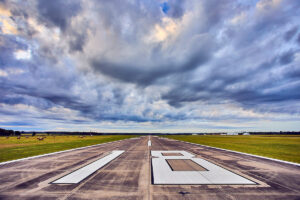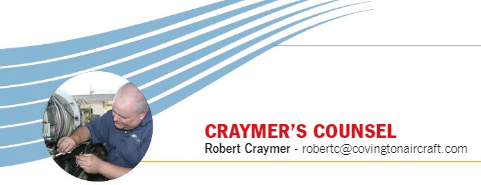
In 2021, we celebrated the 100th year of agricultural aviation, and I celebrated my 25th year with Covington Aircraft. Many achievements in life are marked by time. “Let every man be master of his time.” -William Shakespeare.
Many of you are wondering, Craymer, how are you going to talk about engine maintenance with an opening paragraph about time? Engine maintenance time is tracked by hours, cycles and life-limited components. It used to be that everything was monitored off cycles; however, hours are starting to become as much a part of time tracking now as cycles have been.

Turbine blade maintenance is now being tracked using hours. For some models like the PT6A-65AG, the compressor turbine blades have an inspection that must be done at 3000 hours. Pratt & Whitney Canada calls this inspection a “Creep Check.” The “Creep Check” removes the compressor turbine, a.k.a. CT blades, and checks their growth. This is an inspection that must be done at an engine shop. Your on-wing mechanic will not have all the tooling for blade removal, inspection, installation, and balance. Be advised that this could also result in the shroud segments’ replacement.
Another blade maintenance item can be found on the PT6A-67AG. The replacement of the 2nd stage power turbine blades is recommended by 5000 hours. Don’t be deceived by the word recommended, the replacement of the power turbine blades at 5000 hours is crucial. We have seen several engines that were more than the 5000-hour time frame, and the blades have liberated. Pratt & Whitney Canada has expressed that they can use the term required only in the issuance of an AD, recommended is the strongest language that can be used without an AD.
Be advised there are some commercial support programs to help owners/operators of PT6A-67AG engines with the cost of the blade replacement. One can only take advantage of commercial support programs while the programs are still active and through Pratt & Whitney Canada’s family of approved shops, including Covington Aircraft. As more maintenance is being dictated by hours, you can see the tracking of hours is becoming more and more critical to engine maintenance.

Cycle tracking, on the other hand, has always been important. To clarify, a cycle is defined as a start, a flight, a landing and a shutdown. In agricultural aviation use, we don’t typically utilize the engine and airplane in this manner. One may start the engine once or twice a day and do as many flights as your customers’ applications call for. PWC understands this utilization and has provided us with a means for determining cycle counts using starts and flights. A common question has been asked: Can one determine starts and flights based solely on hours? The answer is no. The owner/operator is responsible for tracking starts and flights and providing those to your maintenance provider or engine shop. Thankfully tools are being introduced to make this a more straightforward process. We have evolved from the days of clicker counters in the cockpit to things like the MVP-50T that can track starts and flights. There are also some flight tracking and job tracking software options available.
I encourage operators to talk to their vendors and suppliers for value-added tools and see if they already have or can add this tracking to their products. We know when a job is inputted that you know how many loads that job will take; therefore, we know how many flights that job will be. Once the hours, starts and flights are provided we will be able to use the formula found in the appropriate service bulletin. For example, the PT6A-34AG formula is found in service bulletin 1302.
Why is all this important? The engine contains several components that are life-limited. They must be replaced when a specific cycle limit has been reached. These components are the compressor rotors, the impeller and the turbine disks. When work is performed on your engine in the shop, the shop must verify that these limits have not been reached. If during a hot section inspection and cycles cannot be determined for the CT disk, replacement is the only option. It cannot be assumed that cycles remain on the disk or any life-limited component. If you must replace the CT disk on your engine, it would cost thousands of dollars. I am not trying to scare you, but I want to show you time tracking directly affects the operating cost of your engine.
As we mark time in our personal and professional lives, make sure and consider that marking time on your engine is equally important. Track your hours. Track your starts. Track your flights. Tracking these will make the time you own/operate your engine easier and cheaper. Be the master of your time.
Please reach out to me at robertc@covingtonaircraft.com if you have any questions, and I’ll be glad to assist.





